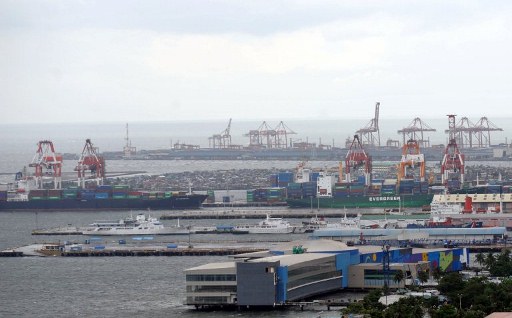
The Manila South Harbor port (AFP FILE PHOTO/TED ALJIBE)
MANILA — The Philippines will withstand a credit bubble as well as economic slowdown in China given relatively lower exports to the mainland compared with other countries in the region, according to the London-based economic research firm Capital Economics.
“Many of the risks facing emerging Asia’s economies have recently started to recede. The big exception is the continued rapid build-up of debt in China, which poses a major threat to the rest of the region,” Capital Economics said in a report titled “China credit bubble is biggest risk facing Emerging Asia.”
“One of the key risks we have been highlighting for a while is the surge in credit growth across large parts of Asia since the global financial crisis, as central banks have kept interest rates low to compensate for weak export demand,” Capital Economics said.
In the case of China, Capital Economics said “debt has risen far faster than in almost any other major economy on record.”
“Although we do not think a full-scale banking crisis and sharp economic slowdown is imminent, the risks are clearly growing… One concern is that a rise in Chinese defaults creates losses for lenders elsewhere in the region,” Capital Economics said, while noting that direct exposure to China of Asia as a whole remained relatively small.
“In terms of the impact on growth, the main effect is likely to come through the trade channel. Looking at exports to China as a share of GDP [gross domestic product] can exaggerate the importance of Chinese demand, especially in economies where exports have a high import content. It therefore makes sense to look at the value-added represented by exports to China. By this measure, Hong Kong, Taiwan and Malaysia are the most heavily exposed,” according to Capital Economics.
“Since China is the world’s biggest consumer and importer for a range of different commodities, a sharp slowdown in China would result in a big fall in global commodity prices. The region’s main net commodity exporters, Indonesia and Malaysia, would be hit hard. But other economies might actually benefit through this channel, as their commodity import bill would shrink,” Capital Economics added.
In the case of the Philippines, the value-added of exports to China as a share of GDP stood at less than 4 percent, Capital Economics data showed, based on International Monetary Fund and Organization for Economic Cooperation and Development estimates.
As such, Capital Economics said “the economies that appear to be the most exposed to a sharp slowdown in China are Hong Kong, Malaysia and Indonesia” while “the other end of the scale are the Philippines and India, which look well placed to avoid the worst of the fallout.” SFM